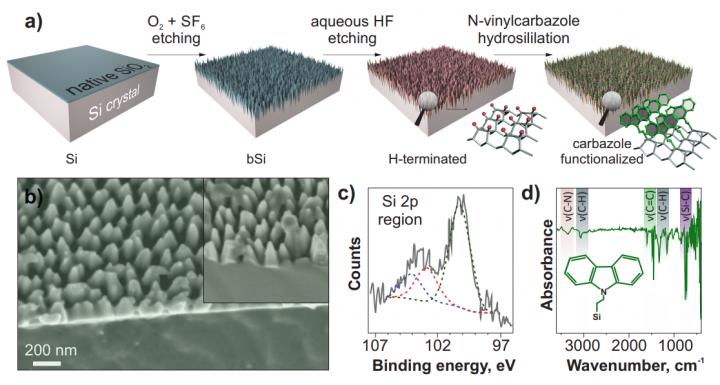Organic substances containing nitrogen are ingredients of many explosives and are present in industrial waste streams, where they pose a significant threat because of their toxicity. Detecting such substances is difficult, partly because they tend to have low vapour pressure and sensors which can detect them tend to be insensitive.
Now, a team of researchers led by a chemist from Far Eastern Federal University (FEFU) in Vladivostok now reports a sensor composed from black silicon, made by etching commercially available silicon substrates, which they claim is highly sensitive to nitroaromatic compounds but does not react to organic substances not containing nitrogen.

Alexander Mironenko, the inventor of the sensor, worked with colleagues across FEFU and with researchers in Melbourne, Australia to develop the technology, which they describe in ACS Sensors. Black silicon is so named because the etching process creates a nanostructured spiky surface.
The researchers coated this surface with a monolayer of carbazole, itself a nitroaromatic compound. It is this coating which gives the sensor the ability to detect its target molecules, as they bind to the carbazole. This changes the fluorescence properties of the coating, creating a physical effect which can be used to determine the concentration of the nitroaromatic substance.
______________________________________________________________________
Further reading
- Spinach plants modified to detect explosives
- Quantum dot sensor simultaneously identifies multiple explosives
- Chip sensitivity heightens detection of explosives______________________________________________________________________
“Nitroaromatic compounds can be found in the waste waters of paint plants or military facilities and are extremely dangerous for the environment. Moreover, they are parts of many explosives as well. Their detection in trace concentration represents an important and complex practical task,” said Mironenko. “Our sensor is able to detect nitroaromatic compounds at concentrations down to ppt (part per trillion). Extremely broad dynamic measurement range is caused by the unique spiky morphology of black silicon that provides uneven local concentration of carbazole molecules creating surface sites with different sensitivity.”
The production of the black silicon and the coating process are both relatively cheap, and produce a sensor that can be used multiple times, the researchers claim. It could be part of ecological or security monitoring systems for detecting explosives at airports.











Motorists need incentives to buy EVs - report
Frankly a £1000 cut on VAT will make little difference if buyers cannot be tempted by the completely unsustainable level of discounting being offered...